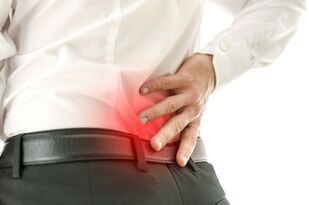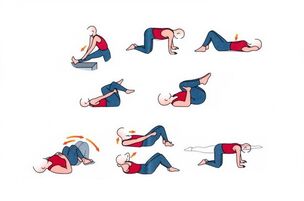Unfortunately, there are no completely healthy people in the world. Each of us from time to time worries about something in the state of our body. Maybe that's why we wish each other good health and prosperity, which is strengthened by a good mood.
Back pain is one of the most common complaints. As a child, it seemed to us to belong only to the elderly, but as an adult, it became a reality. We are not insured against back pain due to age, social status or type of activity. And this is primarily due to the variety and different manifestations of the causes of pain in the lower back.
Diseases that cause back pain
Often, back pain is caused by and as a result of a specific disease - a symptom that allows you to purposefully diagnose the nature, make a correct diagnosis and show the ways, methods, techniques and tactics of treatment of the disease.

Low back pain is either primary or secondary.
Primary, directly related to spinal diseases:
- osteochondrosis or dystrophic disorders of the articular cartilage (one third of the total number of patients);
- "protrusion" of the intervertebral disc outside the spinal cord (protrusion), displacement of the disc nucleus where the annular fibrosis is broken (intervertebral hernia);
- displacement of one or more vertebrae: forward, backward;
- accelerated aging and destruction of cartilage of intervertebral joints (spondyloarthritis);
- thorny growth of bone tissue along the edges of the spine (spondylosis).
Secondary pain is triggered by diseases of other organs:
- vertebral fractures due to trauma or osteoporosis (increased fragility of bones);
- the appearance of a tumor in one of the parts of the spinal canal (lumen);
- muscle tension;
- congenital insufficient width of the spinal canal;
- all kinds of curvature of the spine and their combination, including the deformation that causes the spine to look "humpy" in the chest;
- various types of arthritis / joint diseases (psoriatic, rheumatic and others);
- vertebral tuberculosis and other inflammatory processes affecting the intervertebral discs;
- kidney / urinary stones, pyelonephritis (kidney damage);
- ovarian cysts, including cancer;
- Back pain is also possible as a complication of pregnancy in women.
What can the nature of low back pain indicate?
Of course, it is impossible to independently diagnose the degree, level and type of back pain. However, some specific symptoms when we have back pain show us a certain disease.
Severe pain
When the pain in the lower back is severe, the patient most likely has osteochondrosis or sciatica. Moreover, in the first case, it manifests itself in the process of walking when a person sits for a long time, lifts weight or coughs or sneezes. In some cases, there may be complaints that the back hurts and that the pain spreads to the legs.
If we talk about radiculitis, the patient describes the pain as sharp or dull, painful, often - one-sided, and the bud, lower leg, bud "responds". With walking, with a change in the condition of the human body, it can increase with coughing.
What can acute back pain indicate?
In case of acute pain, you should talk about the following:
- muscle stretching;
- long-term work in an uncomfortable situation for the highway;
- still low back pain after sleep due to the restless state of the body and staying for a significant period of time;
- pain caused by lifting or carrying a weight, falling, impact or sudden movement;
- hypothermia or prolonged confusion;
- also has the possibility of suffering from lumbago (called lumbago) from patients engaged in heavy physical labor. In this case, back pain can last for several days, but can also accompany a person by dragging for two or more weeks;
- Dislocations of the intervertebral discs in the lumbar region - often a spinal fracture, osteochondrosis, interaction with heavy objects (especially lifting them), as a result of strenuous physical activity or as a result of targeted surgery. waist.

The painful nature of pain: what is it talking about?
Painful pain (the patient may describe the condition as "low back pain" or "low back pain") - often manifests itself in the process of inflammation of the back muscles.
This disease occurs as a result of hypothermia or sudden muscle tension / overexertion. In this case, the patient defines the pain as pain that closes the lower back and is accompanied by sharp pain during movement.
Chronic, persistent back pain
If you have back pain and even the patient can describe it as chronic, it is likely that the diagnosis will be made:
- spondylosis deformities - an increase in the amount of spinal bone tissue due to the formation of spinal-like growths on the edge of the spine (especially in the lumbar region, severe back pain that can combine numbness and / or weakness in the legs);
- vertebral joint disease - the most chronic systemic character;
- a number of oncological diseases;
- metabolic disease.
Pain moving without permanent localization
One of the most difficult things to diagnose is the pain that moves from time to time. At the same time, a person can be sure that he has back pain, although in fact the body "cheats" him, and the disease has spread to other organs.
These pains are often caused by diseases of the pelvic organs. The inflammatory process in the kidneys, pancreatic diseases, can cause back pain in the large intestine, and can also occur due to painful changes in bone tissue and tumors of a different nature.
Sometimes back pain is confused with pain in the shoulder blades. However, these are still different types of pain, and they are more often associated with different diseases. Thus, pain in the shoulder blades indicates a stomach ulcer, myocardial infarction, intercostal neuralgia, and even a person's psychological problems.

If you have difficulty independently identifying the area where the pain occurs, and it is regular or acute, you should see a doctor immediately!
Injuries that cause back pain
Strange, but often the cause of back pain is an injury that a person has suffered - for example, damage to the muscles of the spine or sprains. Timely consultation with a doctor is a guarantee of correct diagnosis and effectiveness of treatment.
In advanced cases, there is a high probability of complications, except for a severe curvature of the spine.
Features of low back pain in women
"What are the specific causes of back pain in women? " you ask. And we will answer that they are not small. In general, people can thank the Creator for not having these reasons.
Among the "provocateurs" of back pain in women are:
- ranges / periods;
- pregnancy;
- summit.
In each of these cases, the pain may be of a different nature. For immediate reasons, depending on the characteristics of the female body, the degree of stress in the waist during pregnancy, the woman's age, employment, type of professional activity - the pain manifests itself in different ways.
What about men?
Unfortunately, painful back syndrome is very common in men.
And without the female component, there is enough reason for it:
- stretching (muscle, accompanied by sharp pain);
- Spinal fractures (when a person falls or a man is hit in the back), men are often injured in car accidents;
- When a protrusion / swelling of the intervertebral disc or the dislocation of several intervertebral discs begins to put pressure on the nerve roots, this pathology usually occurs and is diagnosed with excessive physical activity;
- Growth of genital cancer metastases in men occurs after the age of 50 at most; at the same time, the pain develops with a change in the degree of damage to bone tissue and is so strong that it can be stopped only by taking special drugs, analgesics;
- spondyloarthritis (when one nerve root or several roots are damaged in the area of the intervertebral canal);
- indicates the presence and development of prostate disease, liver or kidney problems if painful manifestations are prevalent.
Risk factors: what can cause back pain?
Unfortunately, we cannot insure ourselves against this or that disease. However, we are able to study the risk factors - the most common causes of the onset of the disease and take measures to eliminate them (if possible) or to partially neutralize their effects on the body.
The most common and obvious risk factors for low back pain are:
- Intensive training with great physical strength (gym), especially in the lower back and lumbar spine;
- sudden awkward movement;
- Staying in the same situation for a significant period of time (for example, people whose activities are related to driving a car, working on a computer, and even work that a person has to stop for a long time - store consultants, pharmacists) in pharmacies, factory mechanics, etc. );
- In the morning, there may be back pain, which "speaks" that the mattress or pillow is not suitable for you, but does not exclude the inflammatory process, which manifests itself symptomatically;
- Work based on great physical or psychological stress, stress can also manifest itself in back pain;
- As mentioned earlier, pregnancy and childbirth also increase the likelihood of back pain;
- High weight and back pain are also closely related, as the force exerted on a person's internal organs and spine depends on their total body weight.

When do you need medical help?
Just as we hate getting sick, we hate asking doctors for help. There are many ways to independently determine the causes of diseases and their treatment. Of course, there are reasons for this belief.
But I want to be different in the case of back pain: here you can lie down, get treatment on your own, but here - without the help of a doctor, sometimes urgently! - just not enough.
We can say unequivocally that if the pain is one-time in nature or the cause of the pain is a woman's line, then in principle you should not panic, but wait, observe the body, give it a chance to rest, do not overload.
If the pain is not delayed and does not recur, you have correctly identified the cause and can do it without medical intervention.
For low back pain:
- is repeated systematically;
- pass and continue;
- is amplified;
- pain lasts more than three days;
- is repeated in the morning;
- you are injured and you associate low back pain with it;
- to feel pain in the back and legs (feet and lower legs) at the same time;
- or - pain in the lower back is combined, and at the same time the thighs and legs (thighs, lower legs, feet) and even the groin area are numb - this is a serious reason to see a doctor immediately!

In none of the above cases do you need to guess, you are looking for the causes of the pain alone, you are wondering why your back hurts, but you should immediately go to a medical facility. Without medical help, the condition may worsen and treatment will take more time and effort.
Remember that back pain is not a condition you can joke about or hope for "accidentally" (for example, deformities or displacements of the intervertebral discs have never been corrected by themselves).
Failure to diagnose a person in time, as well as proper treatment, can lead to serious, complex diseases, back surgery, and even lower body paralysis and disability.

























